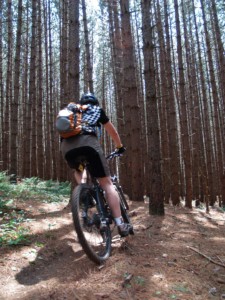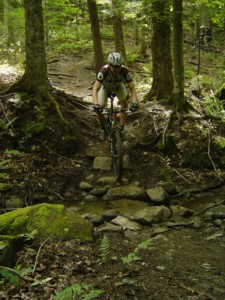After crashing out of my road racing season last spring, I've been expanding my cycling horizons a little bit. I've taken up track cycling as my racing fix, not really looking forward to the press of a criterium peloton in the future. I've also begun to return to my roots: mountain biking. When I first climbed aboard a bike a number of years ago, it was a fat tire mountain bike. I cut my teeth on the rocky, rooty, twisty trails of the Hudson Valley. I voraciously read about mountain biking tips and practiced my skills at every chance I had. I was hooked on riding and places like the Taconic 909, Stewart Buffer Zone and Blue Mountain Reservation were places that I knew better than my own home.
Almost.
Then I found road riding and racing. I spent the past 5 years ignoring those fat tires, cruising around the roads of New Jersey. I raced Battenkill, time trials, stage races, crits and road races, spending countless hours pursuing fitness on skinny tires and super light bikes.
Then I spent 3 months injured because of those road races.
After I got back in the saddle this past summer, I walked into my garage, looked up at my 10-year-old Kona Dawg Primo hanging from the wall and mused about how much fun it might be to get back on the trails. A couple weeks later I climbed aboard a bike that once felt so familiar but now felt completely foreign to me. Thankfully, all of the training I had done meant that only a couple of miles in the saddle would bring back all of those old memories again.
But being out on the trails isn't all fun and games. It's also a great training tool to build strength on the roads. Click through to read some mountain biking tips and training advice. Learn how to use fat tires to make yourself faster in races, on group rides or on your own!
Mountain biking, by its nature, is a discipline that involves a lot of stochastic efforts. Steady state intervals almost never come about unless you're talking about extended climbs such as those found in the mountains, and even those climbs have some varying pitches in them. Because the nature of mountain biking is short, hard efforts, it leads to a lot of physiological adaptation that you may struggle to find on road terrain. The real question is how to use mountain biking training to build crossover fitness and get stronger no matter what bike you ride.
Mountain Biking Tips To Help Build A Big Engine
If you have a mountain bike in your garage or shed, now is the perfect time to get it tuned up and hit the trails. You can follow these mountain biking tips to create big fitness gains that carry over to your other cycling disciplines:
Prioritize Zone 5/6/7 Work
As I mentioned earlier, mountain biking is a very intense, stochastic sport (meaning it has lots of big, hard efforts with short periods of recovery built in between them.) If you look at the profile of your average mountain bike ride, you'll probably see huge spikes of effort (whether you're looking at power or heart rate) followed by periods of doing very little. Compare this to riding on the road and you'll find that road riding is much more “even.” In reality, if you compare the average power output of a mountain bike ride and a road ride, they may be very similar. You just get to that point a little differently.
On a mountain bike, prioritizing zone 5, 6 and 7 work will give you a ton of high-quality training stress as well as making the ride a heck of a lot more fun. You'll build a lot of neuromuscular power by punching up those short, super steep climbs. Anaerobic capacity will be tested by slightly longer efforts and moderate grade uphill grinds while your VO2 max will be pushed to the limit by repeated rollers, stepped climbs and undulating trails.
All of these elements will combine to raise your fitness ceiling, raise your functional threshold power and create fatigue resistance that you can translate to every other kind of riding you do. If you want to really help convert these skills to the road, you can take on Tabata-type intervals on the road to build zone 7 capacity, you can perform my 3221 or 2+1 workout to build zone 6 endurance and lactate tolerance, and you can do a variety of VO2 max efforts (anything from 3-8 minutes) to raise your fitness ceiling.
Get Tons of ME Work (Without Even Realizing It!)
Because the typical terrain of a mountain bike ride is unpaved, dirt, sand, and gravel, there is a significant amount of resistance under your tires at any given time. This simple fact makes mountain biking the perfect medium to prioritize muscular endurance work. Any amount of higher intensity work you perform will require a lot of muscular tension, and you can get even more ME work by simply choosing a little bit harder gear than you normally would.
Powering up short, sharp slopes, grinding up longer climbs and keeping pace on twisty singletrack (the type where you have to stand up and accelerate out of corners to keep your momentum up) are staples of the kind of muscular endurance work you'll be doing. It'll translate over to the road bike (and especially to the cyclocross bike) when it comes to climbing hills or keeping tempo in a paceline full of hardcore machines.
 Learn to Embrace Your Upper Body
Learn to Embrace Your Upper Body
A mountain bike ride is quite unlike a road bike ride in that it requires a huge amount of core and upper body strength and stability to wrestle your bike over obstacles and up climbs. With the wheels constantly shifting under you, core strength is at a premium to ensure the bike doesn't slide out from underneath you and you can continue to pedal through that shifting terrain. Your core and upper body are also highly important when it comes to handling the bike: initiating turns is generally done through the core and hips by leaning into the turn (not via turning the bars) and keeping your front wheel tracking straight through difficult terrain is a function of your upper body.
On top of stabilizing you on the bike, your core and upper body are key to transferring power from your body to the bike. I've talked about the serape effect in the past, but as a quick refresher: there's a subsystem of muscles that act as a sling around your torso. They help to transmit forces from one hip to the other, one shoulder to another and from opposite shoulder to opposite hip. This means power put through one hip will load up the other and torque from the upper body will transfer through into the hips. Mountain biking really challenges this core sub-system and teaches you how to apply that upper body strength to the bike in order to claw your way up steep terrain and over obstacles. Developing this core and upper body strength will help you maintain that aero position on the road and apply extra power during hard, out of the saddle efforts.
 Understand the Importance of Momentum
Understand the Importance of Momentum
When I was just learning to ride and people were giving me mountain biking tips, the one that was impressed upon me the most was the importance of momentum. Mountain biking is ALL about momentum: if you slow down, there's a good chance you won't be able to pick your way through that rock garden or power up that steep slope effectively. Losing your momentum on a mountain bike can often result in you getting off and walking.
While the same is rarely true on a road bike, learning to keep your momentum can be supremely important in rolling terrain. Keeping the momentum you gain downhill will allow you to punch over little rollers and keep your average speed up significantly. On a mountain bike, you're keeping your legs churning through all kinds of terrain: the only time you should be leveling your pedals and coasting is when you're truly flying downhill. On the road, you accomplish this by rolling your climbs and pedaling downhill, hitting the next little roller hard and in a big gear. On descents, it's all about braking hard before a curve, carving into the apex and exiting fast in order to keep your momentum up. In a group situation, hitting the brakes, even feathering the brakes will result in a loss of momentum, and you'll have to expend energy to get your speed back up. No matter what the terrain, keeping your legs turning is a key to maintaining your momentum and your speed.
Get On A Mountain Bike And Watch Your Fitness Skyrocket
The tips above are just the tip of the iceberg when it comes to mountain biking tips. There are entire books written on how to ride a mountain bike, but the tips I've talked about will give you an immediate benefit when you swap back to your road or cyclocross bike. If you want more tips like these, don't forget to subscribe to the Tailwind Coaching Newsletter and share this post with your friends. If you're looking for more ways to boost your fitness, check out my other coaching posts and have a look at my downloadable training plans to find the perfect tools to help you be a stronger, fitter cyclist.
